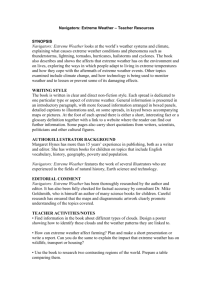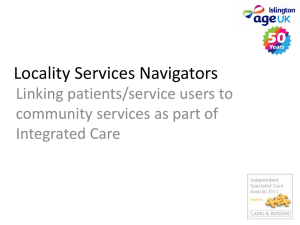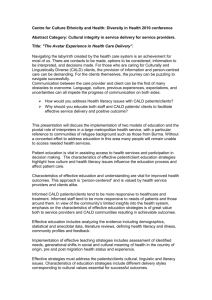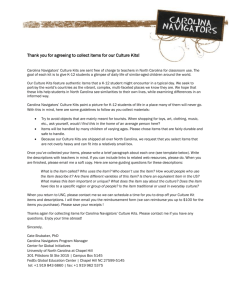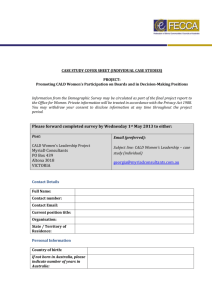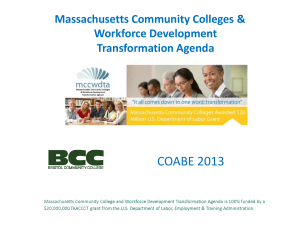Improving the Community Navigator Model
advertisement
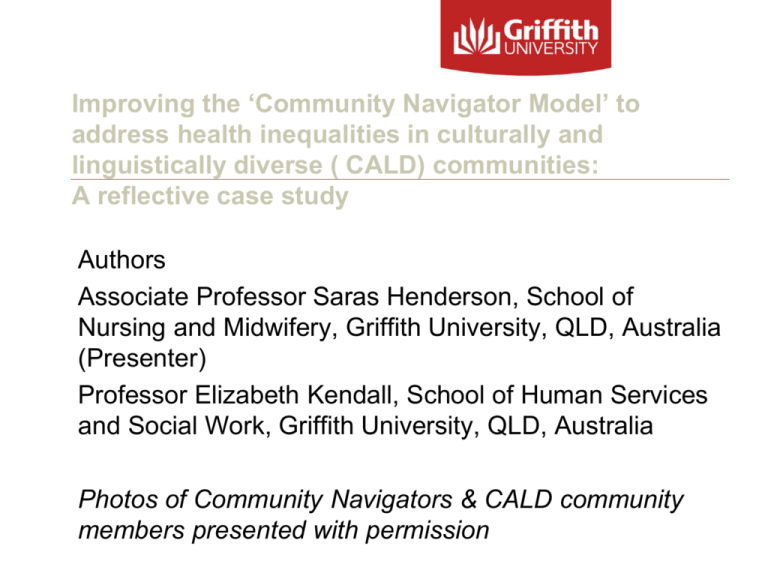
Improving the ‘Community Navigator Model’ to address health inequalities in culturally and linguistically diverse ( CALD) communities: A reflective case study Authors Associate Professor Saras Henderson, School of Nursing and Midwifery, Griffith University, QLD, Australia (Presenter) Professor Elizabeth Kendall, School of Human Services and Social Work, Griffith University, QLD, Australia Photos of Community Navigators & CALD community members presented with permission Surfers Paradise: Gold Coast Queensland, Australia Background The 2011 Australian National Health Reform via the Access and Equity Policy highlights the need to improve health services for all Australians. CALD communities experience lower access to care and poorer health outcomes than the general population due to difficulties navigating the Australian Health System. This leads to CALD communities only seeking health care when their health condition has reached a crisis point which is less than optimal. In response, the Community navigator Model was developed and implemented in four CALD communities (Sudanese, Burmese, Afghani, Pacific Islander) in Southeast QLD, Australia. CALD community members Refugee population in Queensland The Community Navigator Model Nine navigators were selected from the four CALD communities and trained The navigator’s role included: Accessing clients’ needs Facilitating health promotion Supporting community members to access GPs and health services Engaging in cultural advocacy Supporting GPs to use interpreters Facilitating referrals to health services The Navigators from Myanmar, Africa, Samoa Pacific Islander and Afghani Navigators The navigators Were employed within a Non -Government Organisation involved in the model development Worked to support community members in attempts to access health and social services and create opportunities for communities to build relationships with health professionals and service providers Were paid and worked 11 hours/week Kept a record of their activities and outcomes Attended learning circles at the university to gain knowledge about the Health Care System Evaluation of the Navigator Model showed: It was accepted by the CALD communities Was associated with positive health outcomes Increase in the number of visits to the GP Increase in CALD community members seeking mental health services ᵡ emergence of tensions that impacted on the financial, social, and organisational durability of the model affecting sustainability of the model. These tensions needed to be resolved. Methodology Reflective Case Study guided by Donald Schön’s (1983) 5-step approach: Reflection-in–action (our learning and thinking during the implementation process over 12 months) and Reflection-on- action (post evaluation that enabled us to: » Reflect on the initial decisions we made regarding implementation; » Identify tensions and deliberate on how we could resolve these tensions. Schön’s (1983) Five-step process of reflection Report Respond Relate Reason •Reconstruct Method Asking a series of questions » What worked in the model? » What did not work in the model? » What factors enhanced the model? » What factors posed a barrier to the model? Consulting with others » Stakeholders involved in the development of the model » Gate keepers of CALD communities » Local health department Reviewing the navigators’ reports; interviews with the navigators Results Through our reflections and discussions, despite the positive outcomes, we identified four core areas of tension which were: 1. Using a navigator-centric vs community centred approach 2. Training of navigators vs the construction of a learning culture 3. Supporting grassroots approaches vs managing risk within a bureaucratic system 4. Maintaining the integrity of the model vs attracting funds Lessons learned: Possible solutions to ensure sustainability Tension 1 Using a navigator-centric approach We focused on navigators to formally and financially acknowledge their work done in CALD communities which led to work voluntarily done by community members previously was now redirected to the navigators= navigator exhaustion. Solution: Need to focus on a community-centred approach and promote whole-of-community involvement in assisting each other to access health services (LeFebvre & Franke, 2013). Lessons learned: Possible solutions to ensure sustainability Tension 1 Solution cont’d: Navigators to stay in role for short time only and return to the community. Term of navigator to be staggered so when one leaves a new navigator takes up the paid role; eventually building community capacity and increasing health literacy in the community. Cyclic or apprentice model can prevent navigator exhaustion while at the same time increasing the number of experienced navigators in the community and enhancing the community ownership of the approach. Lessons learned: Possible solutions to ensure sustainability Tension 2 Training only for navigators We conducted learning circles only for navigators leading to the community perception that only the navigators had the knowledge. Solution: We need to build learning communities where learning becomes a whole-of-community mandate and members are then more likely to be proactive in seeking health information rather than relying solely on the navigators. Lessons learned: Possible solutions to ensure sustainability Tension 2 Solution cont’d: Demands on navigators will be reduced and health literacy of community members will increase and the success of the navigator role will be enhanced. Investment in community-based learning culture can be less costly and more effective as the information would be disseminated more widely. Easier to conduct a process similar to the learning circle in an environment where community members congregate such as local community halls, churches. Information can be provided on a needs basis depending on the level of health literacy in the community. Lessons learned: Possible solutions to ensure sustainability Tension 3 We supported grassroots approaches with role as the cultural or community way of thinking and acting was accepted by the community. The grassroots modus operandi of communities conflicted with the requirements and rules of the bureaucratic setting in which we placed the navigators. Solution: We needed to work closely with communities to understand their modus operandi and to use this understanding to put structures around the model to manage risk within a bureaucratic system. Lessons learned: Possible solutions to ensure sustainability Tension 3 Solution cont’d: Where appropriate one-to-one advising and supporting rather than a broad-based health promotion mandate. Need to be aware that not all navigators are able to adapt grassroots practices to suit bureaucratic requirements. Support creativity and flexibility. Not assuming that allowing navigators to operate in ways that suited their communities would automatically enhance safety and acceptability. The need to mentor navigators through difficult decision points so they can reach the best outcomes for both the community and their employer. Lessons learned: Possible solutions to ensure sustainability Tension 4 We wanted to maintain the integrity of the model as a community-based response to health promotion rather than driven by the bureaucratic agenda. This was only possible whilst funds were available. Flexible funding was needed to sustain the model which was not readily available leading to navigators becoming frustrated and having to adopt practices as required by the specific funding bodies. This led to the integrity of the model being lost. Lessons learned: Possible solutions to ensure sustainability Solutions: We needed to attract additional financial support in the form of ongoing funds. Our reflection showed that whilst there was enormous enthusiasm and optimism about the opportunity for the community, change occurs slowly and only with intense levels of financial and bureaucratic support could the model be sustained. Paradoxically, the attainment of ongoing funds meant the model became embedded within a minibureaucratic formal structure. The need to simultaneously build flexibility and structure into the navigator role. Conclusion Our paper provides: A perspective on how the development of communitybased service models inherently places them in a position of tension that must be resolved if they are to be sustainable over time. Resolving tensions in culturally appropriate community-based models can create a more durable pool of community navigators that can facilitate community empowerment, self-governance of health issues and a sense of community ownership of health services.
